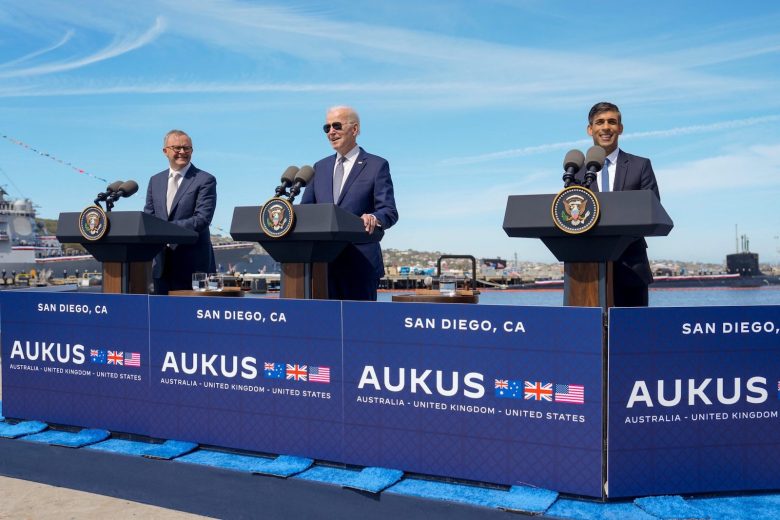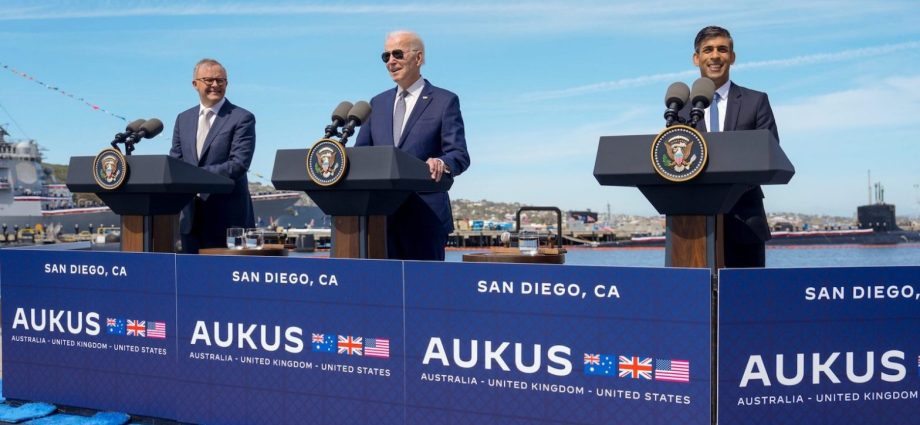The United States, United Kingdom and Australia have announced plans to base nuclear-powered submarines in Western Australia, using the Down Under area as an alternative to strategic bases in Guam while potentially sidestepping nuclear proliferation concerns.
The Insider reported this month that the Biden administration has established Submarine Rotational Forces–West (SRF-West), which are believed to consist of four US Virginia-class nuclear attack submarines (SSN) and one UK Astute-class SSN, and will operate out of HMAS Stirling at the western Australian city of Perth as early as 2027.
The Biden administration stated last month that SRF-West would “help build Australia’s stewardship. It will also bolster deterrence with more US and UK submarines forward in the Indo-Pacific.”
The Insider notes that the establishment of SRF-West comes at a time when US near-peer rivals China and Russia are expanding their submarine fleets, with Russia’s Yasen-class SSNs operating in the Atlantic and Pacific Oceans, and China’s nuclear-powered ballistic missile submarines (SSBNs) constantly patrolling the contested South China Sea.
Sidharth Kaushal notes in a March 2023 Royal United Services Institute (RUSI) article that Australian naval facilities that can base Virginia-class and Astute-class SSNs are relatively out of range from potential missile attacks, providing backup for Guam in case the latter is crippled by Chinese or North Korean “Guam Killer” missiles such as the DF-26 and Hwasong 14/15.
Kaushal notes that US overreliance on Guam has made US naval operations in the Pacific particularly vulnerable, with Guam’s possible loss in a conflict scenario substantially limiting the tempo of US submarine operations in the region and forcing US SSNs to travel longer distances for resupply.
Asia Times this month noted the various strategic challenges of defending Guam against missile attacks. Guam faces the perfect air and missile defense problem, as disjointed US missile defense systems on or near the island may not be effective against a saturation attack involving drones, ballistic missiles, cruise missiles and hypersonic weapons.
These unlinked missile defense systems consisting of the Terminal High Altitude Air Defense (THAAD) and Aegis-equipped nearby warships may fail first contact with advanced missiles, with the sheer number of missiles fired in a saturation attack demanding sensor fusion across various domains such as space and cyber to defeat hypersonic threats.
However, one of the possible strategic implications of the AUKUS submarine project is that it may set a dangerous new nuclear precedent for nuclear proliferation, eroding the international norms and institutions that currently safeguard against proliferation.

In a September 2021 article for Carnegie Endowment for Regional Peace, James Acton notes that AUKUS demonstrates a US double-standard regarding nuclear technology. In the context of AUKUS, Acton says that the bloc can make Australia the first non-nuclear armed state to remove nuclear material from the IAEA inspection system, setting a damaging new precedent for non-proliferation.
Acton mentions that while the Non-Proliferation Treaty (NPT) does not prohibit non-nuclear weapon states from building nuclear-powered ships, the IAEA cannot safeguard naval nuclear reactors, especially those on submarines, due to their secret locations and inaccessibility while submerged.
He also says that the IAEA Comprehensive Safeguards Agreement permits non-nuclear states to withdraw nuclear material for “non-proscribed military activity” such as naval reactors. That, Acton suggests, may set a precedent for other potential nuclear proliferators to exploit the IAEA’s loophole.
He notes that much of the world may see the US’s tacit consent for Australia to use the nuclear propulsion loophole while criticizing and punishing its adversaries for doing the same as a double standard, weakening the deterrent value of IAEA safeguards and making nuclear proliferation more likely.
South Korea in particular may take notice of the naval propulsion loophole to build its undersea nuclear deterrent, raising tensions with North Korea in an already volatile regional security environment.
Asia Times noted in June 2022 that the US and South Korea have agreed to share small modular reactor (SMR) technology, which can pave the way for the latter’s construction of nuclear submarines.
Back in 2003, South Korea launched a covert program to develop nuclear submarines, only to be dissolved the following year after discovering that its scientists dabbled in uranium enrichment that could be used to make nuclear weapons.
Despite that controversy and setback, South Korea never abandoned its plans to have nuclear submarines, with former South Korean president Moon Jae-in mentioning in 2017 that “it’s time for us to acquire nuclear-powered submarines.”
Moon’s successor Yoon Suk Yeol ratcheted the nuclear rhetoric in January 2023 by saying, “it’s possible that the problem gets worse, and our country will introduce tactical nuclear weapons or build them on our own. If that’s the case, we can have our own nuclear weapons pretty quickly, given our scientific and technological capabilities,” the first such statement made by a South Korean leader since 1991.
Joel Ivre points out in a September 2021 Asia-Pacific Leadership Network article that AUKUS weakens South Korea’s commitment to nuclear non-proliferation, as nuclear-powered submarines present a much lower threshold for nuclear proliferation compared to a full nuclear weapons program.

Ivre also says that South Korea’s poor record on non-proliferation runs the risk of nuclear material not subject to IAEA monitoring being diverted for prohibited uses.
Although Ivre notes that a South Korean nuclear weapons program is unlikely, the more immediate result would be a weakening of nuclear non-proliferation norms in a country where they are already significantly weakened, in a region already undergoing a significant arms race.
Other latent nuclear powers in Asia that may take notice of this weakening of proliferation safeguards are Japan and Taiwan, both of which have nuclear power programs and the likely resources, technology and know-how to assemble a nuclear weapon quickly should the perceived need arise.

